Media | Articles
The last great big-block Chevelles won’t be forgotten
Napoleon once said, “Glory is fleeting, but obscurity is forever.” Bear with me—this does relate to cars. Because, inevitably, some cars do just get forgotten, even ones that caused a splash when they were new. The 1953 Packard Caribbean was supposed to be America’s “smartest” and “most glamorous” sports car. Packard went bust only a few years later and most people today have never even heard of the Caribbean. Remember the AMC Rambler? Motor Trend gave it “Car of the Year” accolades in 1963. But if you were born after, say, the Carter administration, you’ve probably never seen one.
Obscurity, however, has never claimed the 1970 Chevelle. By any measure, this peak year for Chevrolet’s bread-and-butter muscle car remains one of the most popular automobiles in the hobby, across both budgets and different generations of enthusiasts.
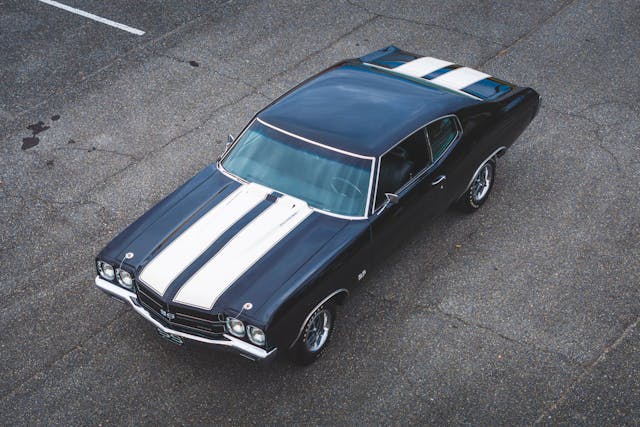
You haven’t been able to drive a new Chevelle off the lot in 46 years. You haven’t been able to drive one of the fast ones off the lot in over half a century. Yet, by make/model, the Chevrolet Chevelle is the fourth-most-insured car on Hagerty policies. Narrowing it down further to year/make/model, the only Chevrolets more popular than the 1970 Chevelle are the 1967, ’68 and ’69 Camaros, and the ’57 Bel Air. That’s a lot of staying power for a 54-year-old car.
There have been plenty of headline-worthy Chevelles from over the years, but it’s no surprise that the 1970 model year cars are the standard bearers for the nameplate from collectibility and valuation perspectives. It was arguably the biggest year for muscle cars as a whole, and the Chevelle came refreshed and ready for a fight. Along with a dramatic restyle, GM finally lifted its self-imposed ban on engines larger than 400 cubic inches in intermediate cars. The monster 454-cubic inch Chevy engine became one of the biggest guns in the muscle car arms race (beaten in cubic inches only by the Oldsmobile, Pontiac, and Buick 455 engines), easily larger than the rival 426 Street Hemi or Boss 429, as well as the biggest mill Chevrolet ever threw into a passenger car.

Six years prior, the Chevelle started with more humble beginnings, but its trajectory toward muscle car greatness wouldn’t take long. After its launch in 1964 as Chevrolet’s entry into the burgeoning mid-size segment, the Chevelle slotted in between the smaller Chevy II and the full-size Impala. Almost immediately, increasingly more potent 283- and 327-cubic-inch V-8s found their way into the Chevelle’s high-performance Malibu SS trims. The Chevelle SS, available with the range-topping big-block 396, became its own distinct series for 1966, the year in which the model also got its first significant facelift. The fenders cut forward towards the headlights for a more aggressive, motion-implying front end, and the roof on coupe models swept back more gracefully. Most memorably, though, the fenders got rounder and bulged at each end for the “Coke bottle” styling that became all the rage in the second half of the ‘60s. A more substantial refresh gave the 1968 Chevelle all-new, even more sculpted bodywork as well as a shorter wheelbase.
Marketplace
Buy and sell classics with confidence
This was further refined in 1970 with a squarer shape, bobbed front and rear ends, subtly-flared fenders, a more prominent grille, and new bumpers. SS models featured a body-colored bar bisecting the blacked-out grille and a domed hood. These more taut, cleaner lines might have been conservative compared to other muscle cars, but there was no question the Chevelle SS meant business. “We made our tough one even tougher,” the ads proclaimed.
But the copywriters were just as likely talking about the big bent-eights underneath the SS’s domed hood, and the beefed up options that came with them. While the still perfectly potent SS 396 stayed on in two different outputs, the big news for 1970 was option code Z15, aka the Chevelle SS 454. Ticking that $503 box added heavy-duty suspension, power front disc brakes, SS wheels, the 454-cu-in LS5 engine (which was also available in the Corvette) rated at 360 hp and 500 lb-ft of torque, and a standard Muncie M21 close-ratio four-speed transmission. An M22 four-speed or three-speed Turbo Hydramatic were also available.
An additional $263 got you the even hotter LS6 engine. A 454 with forged aluminum pistons, forged steel connecting rods and crankshaft, solid lifters, and 11.25:1 compression, the LS6 put 450 hp and 500 lb-ft of torque under your right foot. The one-two punch from these 454s was short-lived, though, as by 1972 the LS6 was canceled, and although the LS5 was still available (except in California), a drop in compression reduced power to 270 net hp.
Muscle car enthusiasts know the well-worn story of emissions legislation, unleaded gasoline mandates, and surging insurance premiums that bled the performance out of performance cars, with a noticeable impact beginning in 1971. Though performance was unbridled in ’70, demand for top-end muscle had already begun to wane—most sources point to fewer than 9000 SS 454s built for 1970, a fraction of the total ’70 Chevelle production that ran into the hundreds of thousands.
Today, though, the past is just context to better appreciate these cars in the flesh. I strolled up to this 1970 SS 454 Sport Coupe, currently listed for sale here on Hagerty Marketplace, and there’s no question that it looks the part. Whereas the scoops, decals, and colors of a GTO Judge or High Impact-painted Mopar embodied the era’s excess, the seriousness of the ’70 Chevelle’s design, especially in Tuxedo Black with broad white stripes, feels more timeless.
As with any muscle car, the option list goes a long way toward shaping a great cruiser, drag strip terror, or something in between. This example left the factory with the LS5 454/360hp engine, M22 “Rock Crusher” four-speed transmission, 3.31 Positraction rear axle, ZL2 cowl-induction hood, Soft-Ray tinted glass, power steering, heavy-duty battery, and pushbutton AM radio.
A $148 option, the cowl-induction hood subtly sets the car apart. Hood pins suggest that this is no ordinary Chevelle, and a vacuum-operated flap toward the cowl flap opens up at full throttle to feed extra cold air to the hungry Holley four-barrel underneath it.
Now, as the ads for this car say, “[t]he performance starts as soon as you’re seated.” The standard bench seat (buckets were available) in the SS puts you in a position few would call “Super Sporty,” but it is comfortable and offers a cool, commanding view of the subtle crease atop each front fender and the big dome in between them.
Of course, the loud parts beneath that dome are the star of the show, hinted at by each fender’s “454” badges but made perfectly clear when you twist the key. Even plodding along in traffic, the big-block growl coursing through the exhaust and rhythmic, urgent idle never let you forget you’re in an old muscle car thrust along by enormous pistons. The angry-sounding engine is the perfect complement to the car’s purposeful looks.
You might expect that implied brawn to present itself in the controls as well, but that’s not the case. The steering wheel is surprisingly thin and almost delicate-feeling, with little feedback and ample power assistance. It takes a decent amount of input before you see actually feel the car begin to turn. The clutch is also reasonably light, and though the beefy Hurst shifter reaching up from the floor does require long and deliberate throws, it doesn’t require much effort to operate.
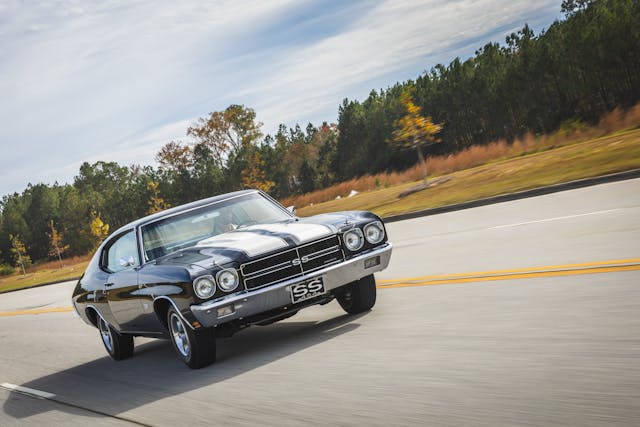
Road testers in-period found that the LS5 Chevelle would hit 60 mph in around six seconds. Five decades on, the numbers might not be much to write home about, but there’s no questioning the Chevelle’s ability to deliver a visceral off-the-line experience. Mashing the throttle on 7.4 liters worth of carbureted V-8 feels like an occasion every single time. The Chevelle certainly feels quite fast, and it sounds even faster. I have no idea how much benefit the cowl-induction hood truly adds, but the little air-inhaling flap dares you to drop the hammer just for that added visual effect just ahead of the windshield. The more powerful LS6 was a tempting value when it was new and it proved a popular option, but at no point driving the LS5 did I think, “boy this is slow, it really needs a few dozen more horses.” It’s still a beast.
The Chevelle doesn’t stop as well as it goes, but that’s to be expected from a front-heavy 53-year-old big-block muscle car. The power front disc/rear drum combo in this one is perfectly adequate. So, somewhat surprisingly, is the handling. It doesn’t change direction like a sports car (nobody would ever expect it to), but it feels planted around a mild bend. Unlike many of the bigger and softer American cars from back then, it’s not just a boat that floats around corners. Compared to a 1967 Chevelle SS 396, it feels tighter, flatter, and faster, a bit like the older car on mild steroids.
When you settle things down and just cruise, the ride turns quite compliant and, loud exhaust notwithstanding, is quite comfortable. When Hot Rod tested an SS 454 in 1970 it called the Chevelle a “pleasant and very predictable road and highway car.” On the right road and in the right weather, that’s still plenty true in 2023, even if the 10-or-so mpg makes for frequent pit stops.
With body styles ranging from sunny day drop-tops to family wagons, a broad engine lineup that included sleepy straight-sixes and the ground-pounding LS6, and long list of trims and options, the Chevelle market can be overwhelming. Even narrowing the view down to just the peak year of 1970 doesn’t help all that much. Condition #2 (“excellent”) values in the Hagerty Price Guide range from $11,800 for a relatively pedestrian 307/200hp-powered Malibu sedan all the way up to $373,000 for an LS6 convertible. It’s the Super Sport models that top the wish lists of most enthusiast collectors, however, and there the picture gets a little clearer.
Being quintessential muscle cars, 1970 SS Chevelles were caught up in the muscle car boom that preceded the 2008 financial crisis, and were equally part of the bust that followed it. LS6s returned to their pre-recession values the quickest, but the other models weren’t too far behind. Today, the LS5, which is technically rarer than the LS6, is worth roughly half as much and arguably the better value. Prices range from $50,100 for a running but rough car in #4 condition to $112,000 for a concours-ready show car. Add about 15 percent for a four-speed over an automatic, and the usual muscle car rules about matching numbers and as much documentation as possible apply here.
When looking at buyer interest for 50-year-old cars, it tends to skew towards people who remember those cars when they were new or new-ish, like baby boomers or older Gen Xers. Not so with the second generation Chevelle. Despite wearing a badge that hasn’t graced a new car in well over 40 years, buyer interest largely mirrors the collector car market as a whole.
Given the huge range of values already mentioned, plus the absolutely enormous aftermarket support, parts availability, and knowledge base for these cars, there’s a Chevelle for every type of enthusiast. The SS 454s are just king of the hill when it comes to desirability.
In its 1970 road test, Hot Rod also proved prophetic about the Chevelle’s place in the future. “The past is gone. The future may never see a car like this…We savored every moment of this car, for the memory may have to last a long time.” It did indeed have to last a while, a couple of decades, even, but performance cars have long since caught up to and far exceeded the levels of the muscle car era. So while “glory is fleeting” rings true for this old car, what about “obscurity forever?” With the scores of people who buy, sell, race, and restore Chevelles, or just have fond memories in one, not yet. Not even close.
**
To view the Hagerty Marketplace online auction listing for this 1970 SS 454 Sport Coupe click here.

***
Check out the Hagerty Media homepage so you don’t miss a single story, or better yet, bookmark it. To get our best stories delivered right to your inbox, subscribe to our newsletters.

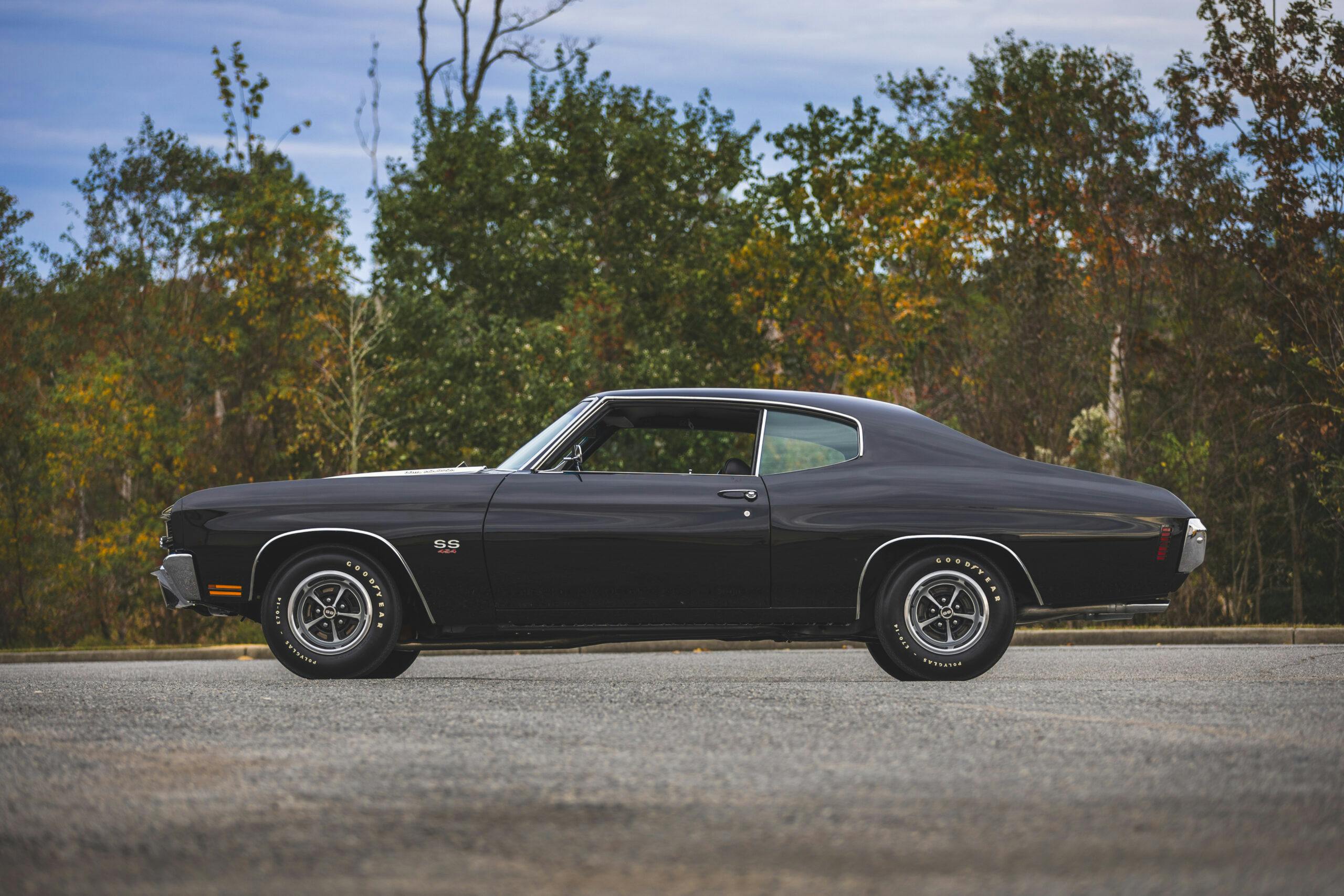

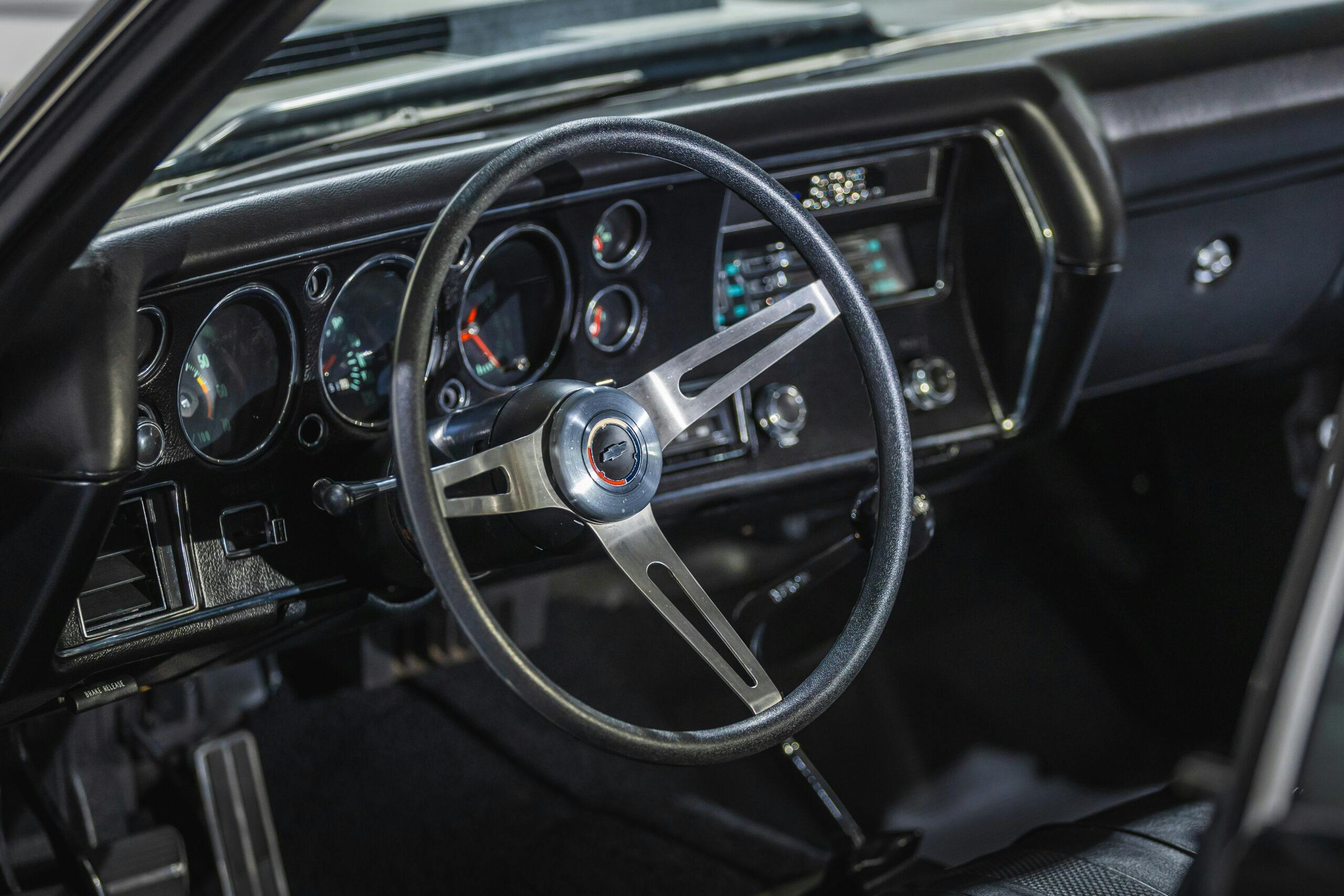
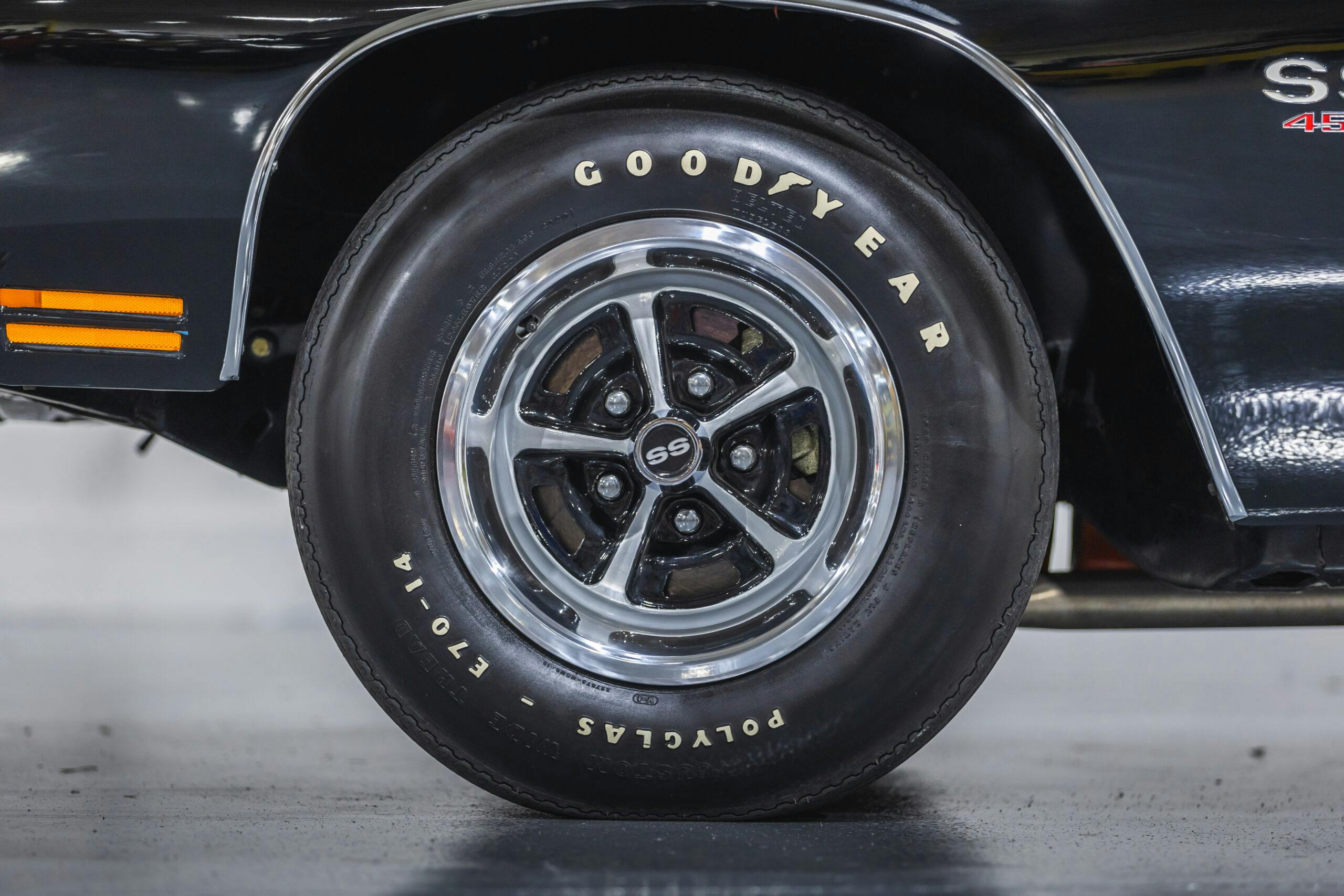
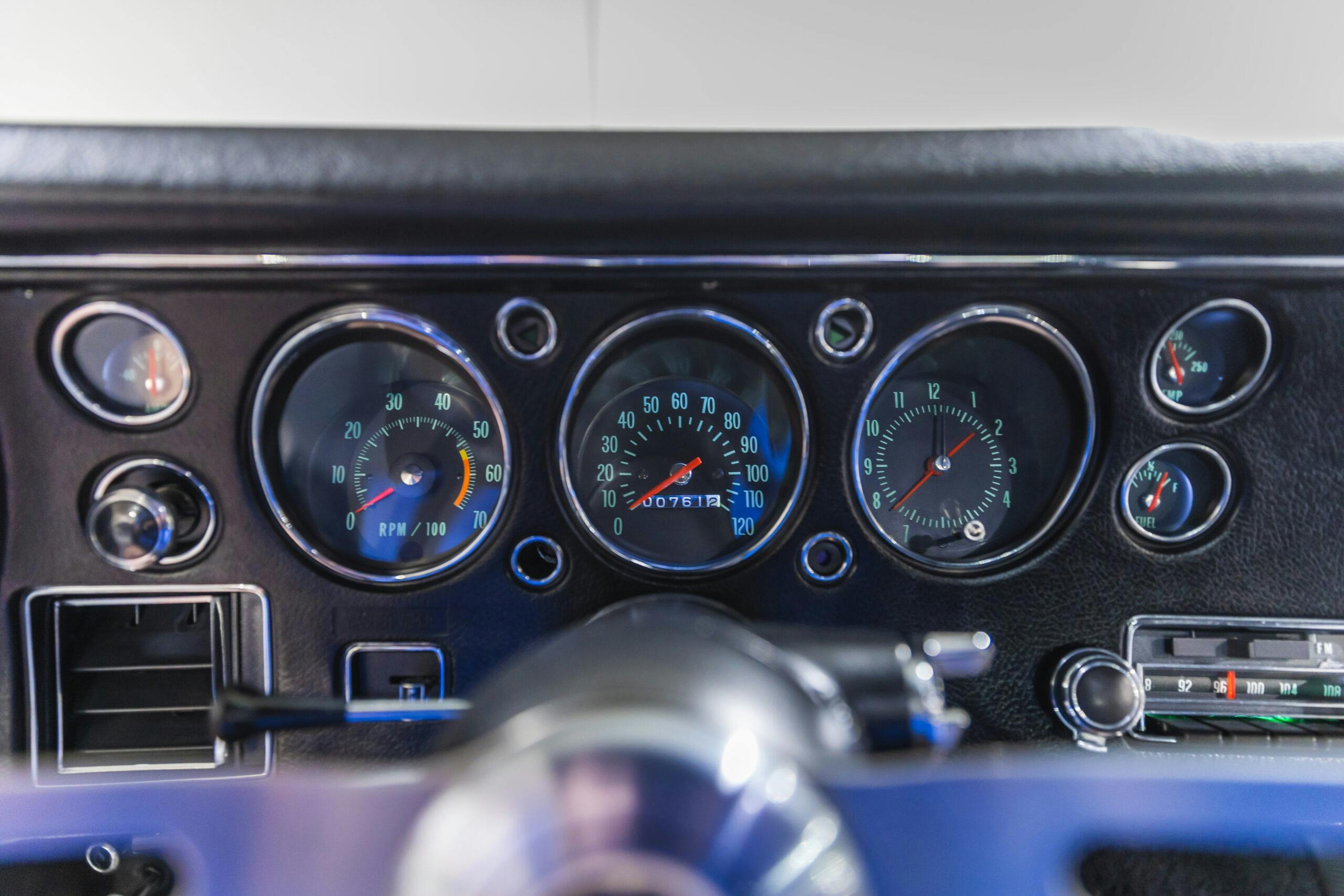
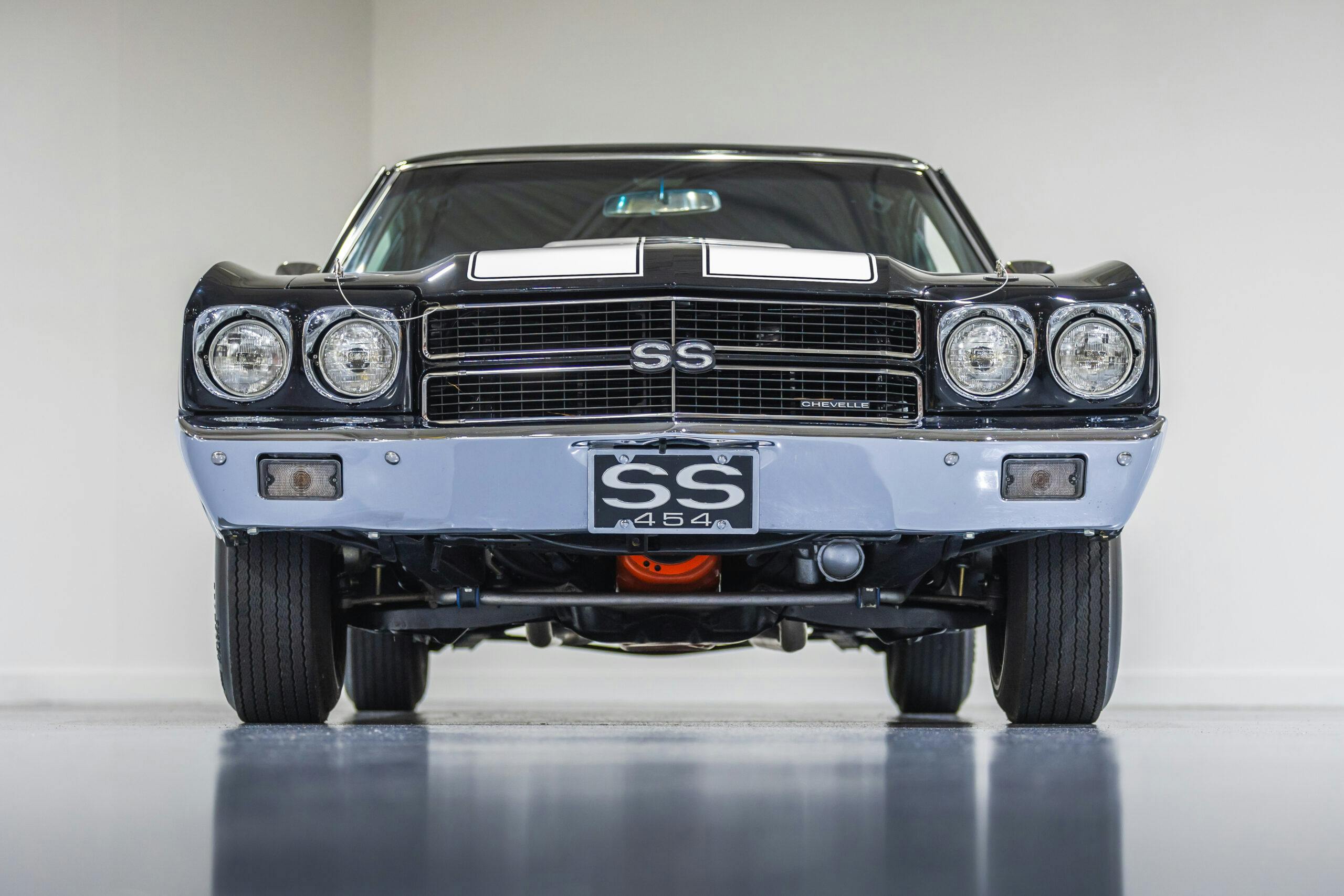
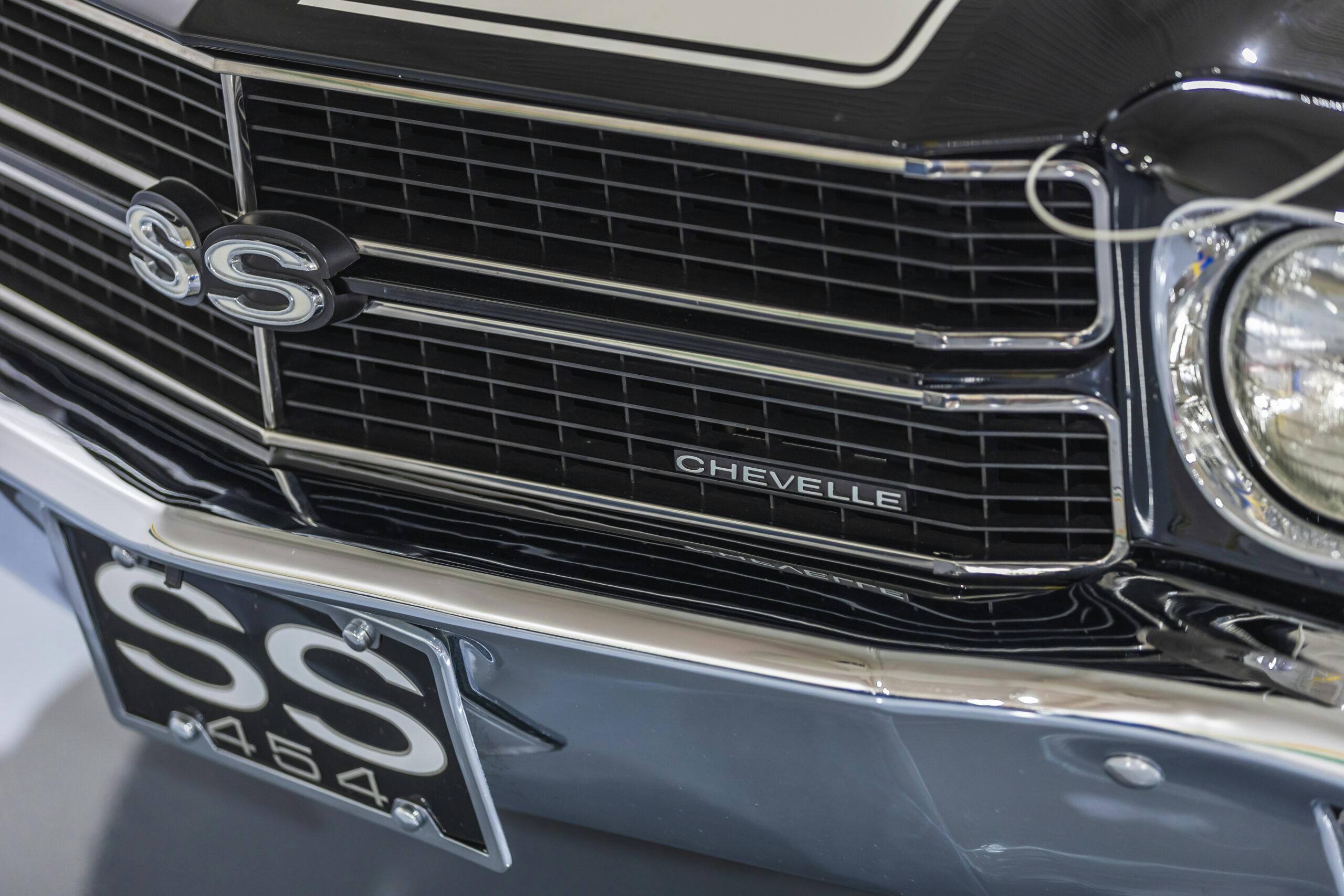















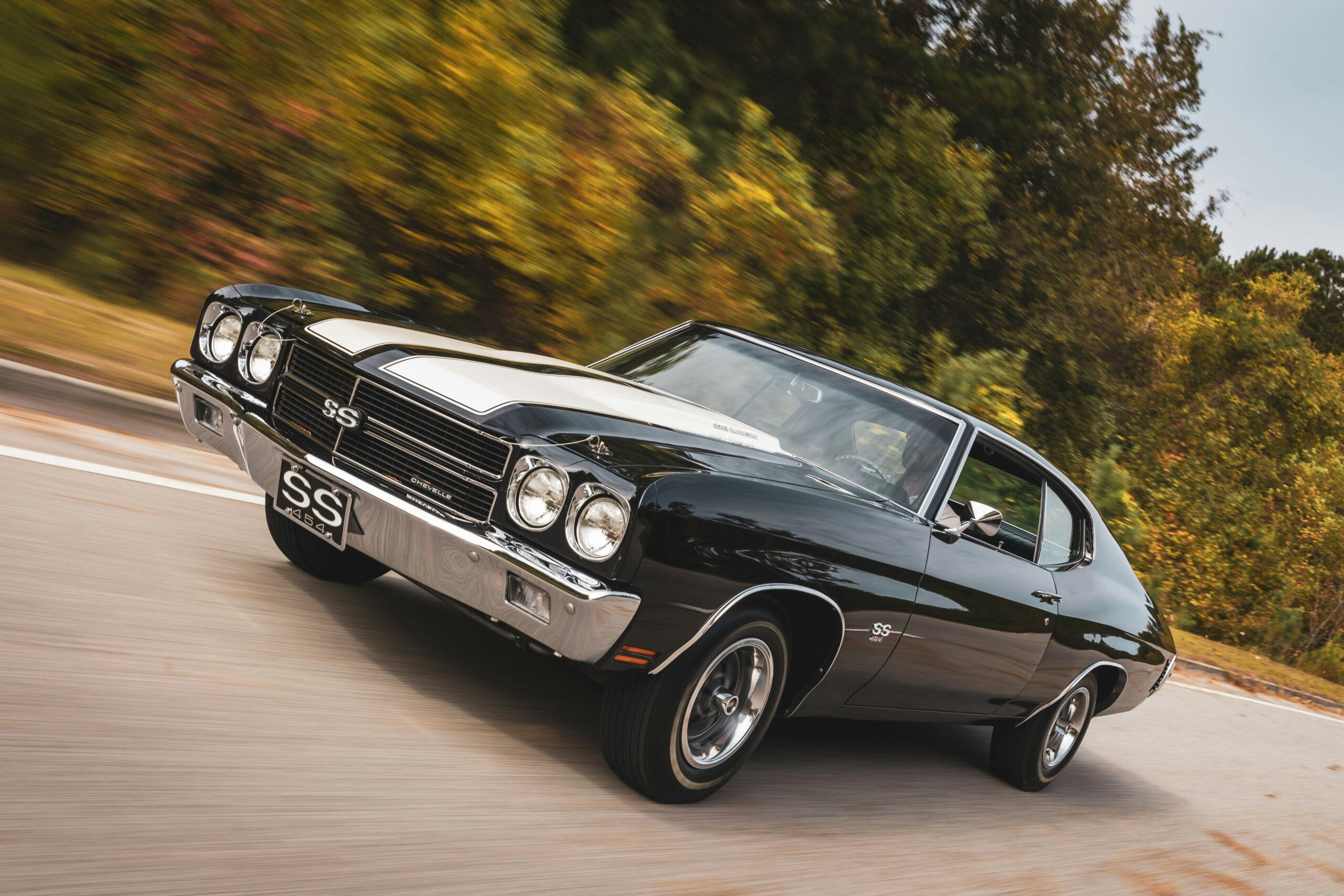
The monster 454-cubic inch Chevy engine became one of the biggest guns in the muscle car arms race (beaten in cubic inches only by the Oldsmobile and Buick 455 engines) – says the article…
“So what am I, Chopped Liver?”, asked the 455 Pontiac!
Ha! Thanks, Dub! This miss is on me. I’ve made the correction.
👍😋
Good call!!! The key word in the title is “GREAT”. The while there were big block Chevelles after 1970, none could be considered great (IMO). Clearly the last great big block Chevelle was the 1970 450-hp (gross) LS6 454. After 1970, the performance when down, FAST.
A good friend of mine had a new 1970 Chevelle with the L48 300-hp (gross) 350 engine. He traded that in on a 1972 Chevelle with the LS5 270-hp (net) 454. He said the 1970 350 would run circles around his 1972 454.
While performance went down quick after 1970 for Chevy, Buick and Olds, the great 455 Pontiac lived on in “Super Duty” moniker as late as 1974. Sure, the 1970 HO-455 didn’t have the HP ratings of the LS6, (some say Pontiac underrated its engines) it was equal in torque (but at a lower rpm).
Bought one new 350 -300 H P 3:55 posi ,12 bolt turbo auto ,run that car drag strip for 2 years complete stock closed exhaust run consecutive times 14:40 . had lots of fun with that car & your right 1971 & up were no compatition.Kept the car for 7 years should never sold it . Ordered the car the way I wanted it.
….and the 1968 Lincoln 460!
When I was in high school (early 80’s), the ultimate redneck car was a 66 Chevelle with a low hanging diff and “tires that go all the way across the back,” as a friend of mine said. In the following years they were turned into low budget race cars and demolished at local circle tracks. Now I look at them and wonder how we failed to appreciate them.
As you say, this car looks the business, unlike some of the baroque monsters it competed with. Proper serious, that car is. I would love a nimble mid-sized car with a standard transmission and the amazing 500 cu. inch Cadillac engine of the 1975 Sedan de Ville that was our daily driver in grad school (it had reached the absolute bottom of its depreciation curve by 1991, but it was an epic trans-continental mile-muncher with tons of space, and got 17 mpg driven sensibly on the highway). Maybe I should build one… if I can find a 500 mill. The 454s I have owned tended to blow out their exhaust gaskets.
My first wife loved her Chevelle and always regretted selling it to her sister. The last time I saw her, she was driving it. I guess she convinced her sister to sell it back to her. Hope so, anyway.
The Chevelle is one of my favorite muscle cars, more so than the Camaro.
What is this Chevy week?
As usual, it’s the car, not the engine that makes the car. A lean, clean machine like the Chevelle is more about looks than the leaky, oil burning, inefficient, oversized engine that is in reality just plain too heavy for the car and it shows up in the handling which is poor. There’s a reason small block Chevy engines show up in everything from Plymouths to Studebakers to T Buckets, they are superior in right sizing, efficiency, durability and they just plain run good. At the end of the day, that’s all that matters when it comes to power. The rest is all ego which most of us outgrow in our early twenties.
For the sake of MPG and aerodynamicist all the style and power of the past has been lost. I know the climate thing but I often wonder what designs and engine modifications could have been accomplished if we only…oh well. I am now and always will be that 8 cylinder guy still driving my 305-87 MC SS and my 5.7 liter 300S.
I wouldn’t agree in saying we lost the power of the past. Each of the big three automakers has a turn-key option for anyone wanting 700hp and they can drive it off the dealer lot. Sure, cars don’t look like they used to (and sometimes that a good thing) but we have power in spades these days–all with better MPG than ever.
Good story. Keep up the good work!
A guy who owned a 1970 LS6 once came out of the Dairy Queen parking lot sideways in 1st gear, hopped sideways in 2nd, torque slid left in 3rd and chirped in 4th.
Nice, but never my favourite Malibu body style; that would be the 1966-67. Second choice would have been the new style for 1978 (no big blocks then, though!) In 1970, I would have much rather driven a Monte Carlo SS454.
The great 70 Chevelle. The car that got me hooked. My buddy Had a 1972 396/402 in it 4 speed. Taped a &100 bill to the dash. Said it was mine if i could grab it after he dumped the clutch. I did not get the $. Instead, i got a memory. Of a lifetime. Thanks Buck
Guy in my home town has had a 70 LS5 that he bought new when he got back from Nam. Black with white stripes like the feature car, but he put Ansen Sprints on it. Last time I talked to him about it, I think he said it had 64k miles. He said he tried to order the LS6, but they wouldn’t let him, hence the LS5. Beautiful car
I’ve always been partial to the ‘68s, but I had a ‘71 Chevelle “Heavy Chevy.” Mostly marketing, I guess. It had a 350 and a three speed manual, and not much else. When I bought it I swapped out the trans for a four speed, and then later a Turbo-Hydramatic auto. It was pretty raw. Maybe not appropriate for a young up-and-coming professional. I sold it and bought a ‘72 Monte Carlo SS454. 🙂
It’s replaced the ’55 as my favorite, not-a-Corvette, Chevrolet. (I currently own a ’14 C7 with 14,500 miles.)
Worked at a Chevy dealer in Orange Co. in early 70s. Cust. ordered a 70 Chevelle LS6 that came in one day. Red/black. Beefed turbo 400. Yes, factory. After servicing it, of course I had to check it. W/o torquing it up it lit up the tires for a hundred yards, and smoke!!! Of course someone saw what I did in that quiet neighborhood and this 20 year old was working at down the road motors by the end of the week